|
|
|
|
|
|
|
|
|
|
|
|
|
 |
 |
 |
 |
|
 |
 |
|
|
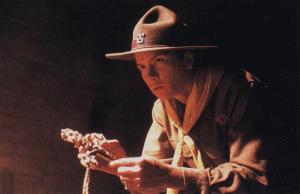
| FAQ
Frequently
Asked
Questions
Use this section to find out (quite a bit) about the BSA Program, and the degree to which Troop 792 embraces the way it "aught to be".
| (What is “Boy Scouting”?)Scouting is unlike anything your son has ever experienced before.
Unlike school, organized sports, or perhaps even in the home setting, in a Boy Scout troop the youth are the ones who are in charge. THEIR desires become our agenda. THEIR ideas for adventure, fun, and excitement are what the adults guide them to bring into reality. In Scouting, THEY speak and the adults listen.
By practicing representative democracy, they pick their own leaders who form the "Patrol Leader Council" that creates the yearly agenda. Scouts work together on every issue, from what to eat at camp, deciding who will wash dishes and shop for food, they learn and put into practice communication, public speaking, teamwork, conflict resolution, and leadership.
By taking advantage of any of the 130 possible merit badges, they gain exposure to areas of interest ranging from Rifle Shooting to Chemistry, from Small Boat Sailing to Aviation, and from Reading to Nuclear Science. Statistically, the Merit Badge program often leads to life-long hobbies and even career choices. At a minimum, Merit Badges help a young man try things he may never have had a chance to do if not for the Scouting experience, such as rifle shooting, archery, sailing, or camping.
While boys are busy "being Scouts" and having fun, they start to embody the virtues of Scouting defined in the Scout Oath and Law.
What is Scouting? It's "fun with a purpose".(What do boys do as “Boy Scouts”?) 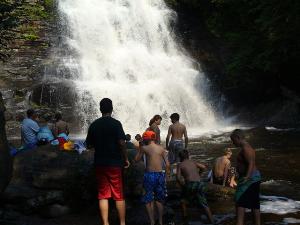
| The Boy Scout Of America Program is a 103 year old, professionally crafted, program of education and character development. By using the "Outdoor Method" (camping, fishing, rock climbing, etc) boys work together to do "the things boys like to do". In the process, they learn the value of teamwork, honesty, communication, mutual respect, and more as they work towards their goal and overcome any obstacles they encounter.
By employing the Methods of Scouting, we reinforce the AIMS of Scouting, which are reflected in our Oath and Law. The goal is to see that they become permanent fixtures in the character of each Boy Scout as we teach them to be Trustworthy, Loyal, Helpful, Friendly, Courteous, Kind, Obedient, Cheerful, Thrifty, Brave, Clean, and Reverent.
Most boys get to do things and go places they would have never had the opportunity to do if not for being involved in Scouting.
Ever climb the highest peak east of the Rockies?
Ever swim under the largest waterfall in Maryland?
Ever spend 5 days canoeing down the Colorado River?
Ever try shooting rifles, shot guns, and bows & arrows?
Ever try biking 50+ miles at a time?
Ever try fishing? How about fly-fishing?
Ever cook over an open fire?
Ever spend the night in a tent? How about an "emergency shelter" you created in the woods?
Ever see the stars from parts of Colorado where there's no "light pollution"?... a sky so clear you can see the Milky Way?
THESE ARE A FEW THINGS THAT WE PLAN ON DOING!
| (What do you mean “Boy Lead”)A Boy Scout troop leads itself. Adults are present to guide and ensure safety & compliance exists, but it is the YOUTH who make key decisions. The primary role of the Scoutmaster is to teach the Senior Patrol Leader how to run/lead his troop.
The Scouting program using The Patrol Method means the Troop members ELECT their own leaders; individual Patrol Leaders and a Senior Patrol Leader (SPL) who takes on "ownership" and hold the actual leadership position within the Troop. The SPL appoints an assistant scout (Assistant Senior Patrol Leader - ASPL) and various other leadership positions, all of whom serve at the Scoutmaster's discretion.
While serving as Senior Leaders, the SPL and ASPL cease to be members of their respective patrols and function as peers with the adult leadership. The SPL and ASP execute Program decisions, lead the meetings, plan agendas, pick camping destinations, and LEAD BY EXAMPLE when executing the agenda that the boys themselves created and agreed to follow.
Patrol Leaders are responsible for the well being and actions of their individual patrol and will REPRESENT their patrol in the Patrol Leaders Council (PLC).
At the PLC meeting (chaired by the SPL and monitored by the Scoutmaster or Assistant Scoutmaster), Patrol Leaders plan future trips and troop meetings. Through a model of Representative Government, they CHOOSE the trips and activities THEY want to do, and appoint other scouts to serve as skill instructors, or lead games or other activities. Adult leadership keeps them on track with suggestions and advice, but the decisions are ultimately left to THE BOYS.
Once the future meetings/camping trips are planned, the SPL and Scoutmaster present the PLC's plans to the Troop Committee for review. The agenda is checked for issues such as necessary fund raising, unique equipment/skills, camp ground reservations, and is given an over-all inspection to confirm that trips are aligned with the purpose of the Scouting Program. If the plans are approved, and the weekly meetings are lead by the boys (as designed) unless the skill instruction needed is currently beyond the skill set of the Scouts, or relates to merit badge requirements, then adults will render assistance.
Adults are a resource for guidance and ensuring that things are done the "BSA way" for safety, youth development and general direction setting.
"Boy Leadership" really means the Troop is doing the things the BOYS THEMSELVES want to do, and in doing so, will develop the leadership, communication, problem resolution, and organizational skills that underscore why Scouts excel in all other areas of their lives.(If Scouting is “boy led”, why have the adult leaders?) 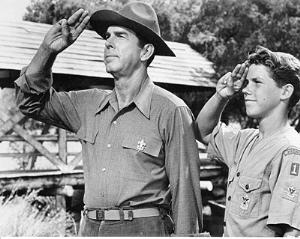
| A Boy Scout troop is "boy run", and the functioning boss is one of the Boy Scouts who serves as the Senior Patrol Leader (SPL). He's elected to that position by all the Scouts in the troop and typically serves for a 6 month term (he is allowed to run for re-election).
However, just because a patch is sewn on your sleeve designating you as the "leader", it doesn't mean that you actually know HOW to lead. That's where the adults come in.
The Scoutmaster's job is to teach the boys how to lead their own unit. That seems to be more of a "journey" than a "destination" because in 6 months, a new election is held. The next Scout to be elected as the SPL may have strong leadership skills, or may be be starting to develop them for the first time so getting to a "100% boy run" status is difficult.
Sometimes we're able to be more "out of the way" than others, but our goal is to let the youth leaders "lead" and only step in when necessary, even if that means letting them make a few mistakes along the way. | (Where would I fit as an adult leader?) 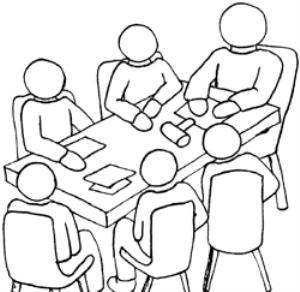
| Boys are Scouts. Adults are Scouters.
As a Scouter, you can serve in 3 capacities in a local Scout unit. Other positions exist at the District level, but we're focused on the Troop on this FAQ.
Scoutmaster (SM) / Assistant Scoutmaster (ASM)- these Scouters work closest with the Scouts and ensure the program is running as it should. Their primary focus is to support the Senior Patrol Leader and Assistant Senior Patrol Leader by guiding them in leadership of the Troop while delivering the "Program".
Merit Badge Councilor (MBC) - a MBC works with Scouts on an individual basis to work on the specific badges (from 1 to 140) that the MBC is registered to teach. A MBC works with the Scouts "on demand" when he is contacted by the Scouts requesting time to complete badge work.
Committee Member - the role of the committee is to provide the Scoutmaster with the support needed to deliver the program that the Patrol Leader Council chooses as the "Program". The Committee provides the logistical support (funds/fund raisers, camping equipment, Treasury, camp site reservations, recording advancement, Boards of Review, registration/recharter, etc) needed to support the Troop. The Committee also has the responsibility to ensure that the Scoutmaster and the PLC are delivering a program that is aligned with the BSA Charter. If not, the Committee can recommend replacements. The Committee Chair would report to the Charter Organization which has the authority to hire/fire adult leaders.
The Committee is headed by a Committee Chairman who functions as the "great organizer" to make sure that sub-committees are on-task in their roles within the troop, such as ensuring a Treasurer delivers a Treasurer's report... Outdoor Chair is making campsite reservations.... Quartermaster is maintaining the camping equipment.... webmaster(s) are updating the website... etc. To avoid "power plays" the Committee Chair is more of an "organizer" than a "position of authority". Committee decisions are made via parliamentary procedure and voting. The Committee Chair does not get to cast a vote unless votes are tied. By design, the Scoutmaster and assistants are NOT members of the Committee, and therefore cannot vote on committee decisions.
There are a myriad of positions needed to staff a strong committee, so most adults in a troop are registered as Committee Members. | (I wasn’t a Scout as a boy, can I be a Scout Leader)All are welcome to contribute as much as they would like as a uniformed leader, Committee Member, or a Merit Badge Councilor (MBC).
As a Committee Member, you should be willing to attend the monthly Committee Meeting (Sunday after the 1st Monday of the month, 7PM) and get involved in as much/little upcoming activities as you wish.
As a Merit Badge Councilor, you choose to provide counseling from 1 to many of the available 130+ Merit Badges. YOU DO NOT need to be an "expert" to be a councilor, as the $4.59 handbooks will cover ALL that you need to know to learn/teach each particular badge.
As a Merit Badge Councilor, your time is ONLY used "upon request" when a Scout decides he would like to work on a particular badge for which you've agreed to be a councilor. Merit Badges are earned OUTSIDE of the weekly meeting, so Scouts meet with you ON YOUR SCHEDULE of availability.
Note: all leaders must complete a BSA Adult Application, which requires you to provide your Social Security Number. A background check will be done by the Longs Peak Area Council. WE (Troop) will NOT know of the particular details of anyone's record, but will simply be told "yes/no" regarding your eligibility. If you do not provide your SSN, you will not be accepted as a leader. This is National BSA policy, not an ad hoc policy of Troop 792.
(What is so special about “Eagle Scout”?) 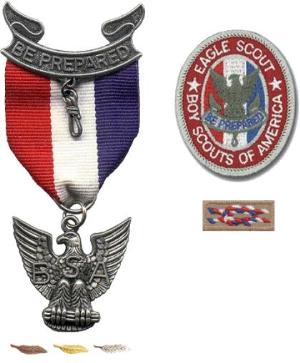
| Becoming an Eagle Scout is no small achievement. In fact, among adults who have gone on to become astronauts, doctors, politicians, or business leaders, most of them will say that earning their Eagle is clearly among the most important achievements in their lives.
Back to the question... WHY?
Look at it from this angle.... ADVANCEMENT is completely up to the individual Scout. If he has no desire or sense of committment to advance in rank, that is his choice. IT IS POSSIBLE for a boy to attend EVERY meeting and EVERY camping trip, and never make it through 1/2 of the available ranks if he isn't motivated enough to take the extra step of demonstrating skills or earning merit badges. Statistically speaking, only 2 out of 100 boys in Scouting will push themselves to become Eagle Scouts.
The "Trail to Eagle" is one of persistence, dedication, well-rounded learning experiences by earning 21+ merit badges, strong attendance at meetings and camping trips, and hundreds of hours of community service.... all culminating with the planning and complete execution of the scout's "Eagle Project" before his 18th birthday.
The "Eagle Project" is SO MUCH MORE than "giving something back to the community" (which it is, and let's not minimize the importance of community and charity). It is actually his "final exam" in Scouting.
He manages his Eagle Project. He will put to use all of the lessons he learned as a Boy Scout; communicating, organizing, recruiting, conceiving an idea, selling the idea, planning the work, assigning work details to those helping him, being the "accountant" that tracks the hours worked and the money spent, etc. In every conceiveable way, HE is the "project leader".
These are the highly desirable skills and traits that makes "Eagle Scout" stand out on a job resume or college application, and the fact that such skills and moral foundations are learned/mastered before "society" recognizes the scout as an "adult"... simply amazing!
| (What is the purpose of a “patrol”?)A significant part of the Scouting experience is to get plenty of HANDS ON activity. From knot tying, to cooking on a fire and stove, to learning how to use a pocket knife or axe... Scouts "DO".
In order to make sure everyone gets a chance to DO, boys are divided into smaller groups within the Troop so that everyone gets ample opportunity to participate. This is part of what the BSA calls, "The Patrol Method".
Within a patrol-sized group, boys do not get "lost among the crowd" or feel as though their opinions (and votes) don't matter. Each plays a critical and important role in the Patrol's success.
The definition of the "Patrol Method" from the National Council's website...
Patrols are the building blocks of a Boy Scout troop. A patrol is a small group of boys who are similar in age, development, and interests. Working together as a team, patrol members share the responsibility for the patrol's success. They gain confidence by serving in positions of patrol leadership. All patrol members enjoy the friendship, sense of belonging, and achievements of the patrol and of each of its members.
(Why don’t your patrols have boys of mixed ages?)Many troops mix boys of different ages in their patrols. Usually, the justification is "so older boys can teach the younger boys". If that model is working for them, great, but that RARELY works, putting them in the very small minority. Even in Cub Scouting Program, the BSA recognizes the developmental differences in boys of different ages and clarifies the NEED to keep young boys separate from older boys. That model continues in Boy Scouting and Venture Scouting. Most units who use a "mixed age" model experience a lot of bullying and/or intimidation; usually manifesting itself in low-key intimidation; older boys making all the decisions and younger kids quietly following along or being "out voted" or "shouted down" on the decisions. By sheer size/age difference, younger/newer boys end up being intimidated and just "go with the flow", not really getting benefit of the "self-guided" model the BSA laid out. However, the overt mission of this Troop's leadership is to run this unit "by the book". The "book" we refer to is the National BSA Program, and it clearly states that "Patrols are made of boys of similar age, ability, and interests." It is also HIGHLY DESIRED that Patrols be "permanent groups" who become close friends and EVOLVE (through trials and tribulations) into well functioning units (mastering the skills of communication, teamwork, respect, problem resolution, etc). To further justify separating Scouts by ages, keep in mind that Patrols are strongly encouraged to do "patrol activities" (activities away from the rest of the Troop). This is literally impossible to do when a group of 16/17 year old Scouts want to go on a canoe trip or rock climbing and other members in their patrol are FORCED to be left behind because they are 11-13 years old and not skilled, mature, or strong enough to join in on the activity. And the model of age separation continues to appear in Venturing... The Venturing models (once again) REINFORCE the BSA's "group by age and ability" concept by grouping the older boys who seek (and are physically able) to do High Adventure Scouting from those incapable physically or intellectually. There are MANY NUANCES interwoven into this 100 year old program, and none of them exist by accident. When Troops try to "modify" their Program and change/eliminate/ignore certain aspects of how a unit is supposed to operate, they [knowingly or not] deprive their Scouts of the FULL EXPERIENCE designed into being a Boy Scout. (What happens at camping trips?) 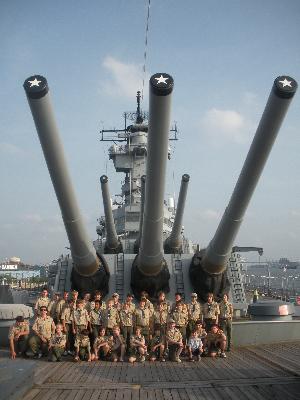
| Camping trips usually follow the following format.
Scouts arrive at Church of Our Saviour in full Field Uniform on a Friday evening, typically at 5 PM so we can depart by 5:30 PM. Once all gear is packed and a final check for permission slips and medications is complete, we depart for our camping destination. Upon arrival, the first order of business is to choose camp sites and set up tents. Once all tents are up, kitchen/cook areas are set up and then all personal gear is stowed. Time permitting, the boys will have "Cracker Barrel" (snack) and the remainder of the night until 11 PM is "free time" for Scouts to unwind and burn off some energy.
Saturday mornings begin with the designated cooks waking up 1/2 hour before reveille and starting to prepare breakfast. At reveille, the rest of the camp will rise. Patrols are encouraged to eat together. Each patrol will have their own dining area, or in the case of a shared pavilion, designated tables. Once KP is complete, there is a flag ceremony and then the Program portion of the day begins with a break for lunch around noon. Program (Scout-skill related activity, and/or the purpose of the camping trip) continues until 5 PM. After dinner, the flag is lowered ceremoniously and there is free time until the Council Fire (at dark). At the Council Fire, boys often perform skits, tell jokes, and enjoy Cracker Barrel.
We generally sleep a little longer on Sunday. Again, cooks are called to prepare breakfast 1/2 hour before their patrols. Cold breakfasts are encouraged, due to the faster KP time. After KP, all scouts are to gather personal gear and then start packing kitchen/dining areas. The tents are the last to be packed, as it is usually necessary to wait until the tents and ground cloths have dried completely before stowing them. A tent put away wet will grow mildew and be ruined in a VERY short time. While waiting for tents to dry, the Troop is lead in a "Scouts' Own" prayer service by the Chaplain's Aid; a boy appointed by the SPL to lead religious events. Once all gear can be packed, camp is struck and we depart for home targeting a return to Church of Our Saviour by 11 AM.
| (How is the weekly/monthly agenda determined?) 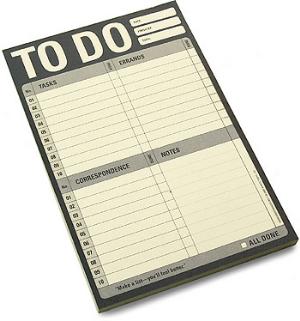
| During the monthly Patrol Leader Council (PLC) meetings, each patrol leader participates in the discussion to plan upcoming camping trips and/or destinations. His choices should be a reflection of the suggestions, ideas, and desires of his fellow patrol members whom he was elected to represent. With the Scoutmaster's guidance, the PLC will debate among themselves which activity(s) are to be part of the Troop's upcoming agenda.
Planning Guidelines for the PLC should follow the basic guideline:
1. Make it fun!
2. Make it exciting!
3. Complete this phrase, "I joined Scouting so I could __________" (fill in the blank)
4. Gear each camping trip to relate to 1 or more Merit Badges and/or rank advancement needs
5. Once the monthly destination is planned, start planning the weekly meetings that prepare for each camping trip.
NOTE: It is not required that the entire troop do the SAME activity at camp! We fully support the concept of "parallel program" where different groups of Scouts may be engaged in different activities. Examples would be a "bike hike" where the boys who don't know or don't prefer to bicycle can opt for hiking or another activity that can be done at the same camp facilities.
The PLC is asked to plan no more than six months in advance. While a longer time horizon would help in planning trips and reserving camp sites, we feel it is important that newly-elected patrol leaders actually get to "lead" on 1 or more trips that they planned entirely. Patrol Leaders serve for terms of 6 months; hence the set time horizon.
Once the monthly destinations/activities are chosen, the PLC then plans the 3 to 4 weekly troop meetings that lead up to each trip, incorporating in each the skill training necessary to make the trip successful. Planning should be very detailed including who will be the skill instructors and how much time of each meeting will be for each part of the nightly agenda. Troop meetings are for "learning", the camping trip is for "doing".
This format ensures that every Scout has exposure and the opportunity to work on Merit Badge requirements. However, the monthly agenda may not be sufficient for Scouts to complete the entire MB requirements and the responsibility is shifted to THEM to engage the Scoutmaster for a blue card and be connected with a Merit Badge Councilor so they can get credit for the work they've done and find out what they need to do to complete the badge on their own.
| (What is a “Patrol Outing”) 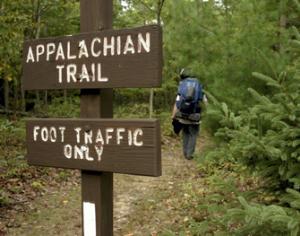
| While there is a planned agenda for the Troop as a whole, individual Patrols are encouraged to participate in their own activities aside from the weekly meeting. For example, if a Patrol wants to hike or visit a zoo, they need not wait until the activity can be scheduled and incorporated into the Troop's annual or semi-annual plan.
Patrol members may plan & execute trips on their own. In this age of Facebook and Twitter, nothing stops a patrol from having spontaneous plans or outings to add to their fun/excitement as Scouts.
The only stipulations would be that any outing done as a "Scout unit" must comply with the Guideline To Safe Scouting, and we'd ask that Patrols not plan trips that are replacements for the scheduled Troop activities.
Patrol Outings are a great way to build unity and teamwork in a patrol, and a great way to keep the program nimble and exciting. | (What are some of the things this troop hopes to do)When it comes to what we do, we're proud to say that we're way past the "recruiting hype". This troop does...
... camp or have a "big idea" occur EVERY month
... visited Mount Rushmore
... hiked the base of Devil's Tower, Wyoming
... climbed Harney Peak (highest point East of Rocky Mountains)
... 5-day canoe trip down the Missouri River
... horseback riding
... fishing and fly-fishing
... shoot rifles and shotguns
... archery
... swam under Maryland's tallest waterfall, Muddy Falls
... 5 to 50 mile bike hikes along the C&O Canal
... 50 mile canoe excursion from Yankton, SD to Ponca, Nebraska
... pioneering projects
... orienteering with map & compass
... hiking
... "Wilderness Survival" weekends sleeping in shelters we built from scratch
... M*A*S*H themed first-aid weekends
... Klondike Derby
... week-long Summer Camp each year
... study mammals, reptiles & amphibians, nature
... study soil & water conservation, oceanography
... fossil hunting (and we have the shark teeth to prove it)
... cooking over open fire
... hosted training weekends for Girl Scouts and younger boys in Cub Scouts
And there is so much more. We do not limit the level of "adventure" the boys want to have. Scouting is a boy led program. The boys decide what we do, and strong, trained, committed adults help them achieve their goals.
What do you want to do?(How much does Scouting cost?)The Troop charges an annual "activity fee" that amounts to a little under $2 per week. First time members pay an additional $25 fee for the initial sign-up fees imposed by National, a copy of the Scout Handbook, and customized Troop hat and neckerchief.
There is a modest "food fee" for each monthly camping trip, and a 1x per year fee if your son attends week-long Summer Camp (highly encouraged!).
Fund Raisers are held as needed to fund new equipment, more elaborate camping destinations, or to allow boys to fund their OWN "scout account".
==================
The Activity Fee - helps to pay for annual registration with the National Council, Boys Life Magazine subscription, liability insurance, numerous awards, badges, pins, camp ground fees, and more. Our fee is usually NOT enough for all the expenses we incur (see fund raising below).
==================
Monthly "camp fee" (food fee) - . Each patrol creates their own menu for the monthly camping trip and can decide to raise or lower this fee to be aligned with their menu choices. TYPICALLY, this is $20-$25 each month. In winter months, or for destinations that are far away, the monthly fee may include extra fees to cover camp ground expenses and help to reimburse gasoline for those transporting Scouts/gear.
==================
Summer Camp Fee - Week-long Summer Camp is a GREAT experience, and we encourage Scouts to attend every year. The average fee is $240. Please start saving for this NOW so that Camp is not a "financial burden" when payment is due (usually by May 1 of each year).
==================
Fund Raising - held as needed to supplement the cost of running the Troop. Covers new/replacement equipment (tents, stoves, cook gear, propane tanks, etc), or to cover the cost of more elaborate camping destinations. A portion of fund raising is usually designated for Scout Accounts to inspire strong participation.
==================
Scout Accounts - The Troop allocates a portion of fund raising to each participating boy's own "Scout Account". This encourages boys to actively participate in fund raising efforts. The harder a Scout works, the more he will earn for himself. Funds are held in escrow by the Troop Treasurer, and can be used to reimburse Scouts for ANY Scouting-related expense.(Does my son have to come every week?)We certainly won't send the "Scout Police" out to find you if you don't show up, but you miss out on a big part of the BSA Program if you don't attend regularly.
Scouting is NOT just playtime, or "Billy's weekend fun" away from his kid sister. Scouting is a carefully crafted character-development program. Each boy is a member of a PATROL, and as such, is part of a smaller group (as compared to the whole Troop of boys) where he is given AMPLE opportunity to play an active and valuable "hands on" role in the patrol's success. A boy who shows up sporadically DEPRIVES himself of the chance to make key decisions within his patrol; choose trip ideas and destinations, make menu selections, divy out workload, and build close friendships. Every meeting includes a period of valuable skill instruction and fun interpatrol competitions that relate to the upcoming camping trip. If a boys misses a meeting, he will find himself less prepared for the upcoming weekend in the outdoors. The troop meetings are where we "learn", but the camping trip is where we reinforce the skills by putting them into practical use.
Scouts should make every effort to attend meetings on a regular basis. Those who don't are missing out on the full experience of their limited Scouting years, and are causing their patrol members to do the same. (What is “Summer Camp”?) 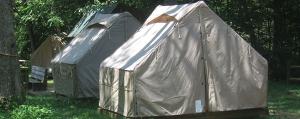
| Summer camp is a week long experience in "Scout life", and a lot of fun! It's held at Council-run scout camps like Ben Delatour, or other BSA-owned properties. It is staffed with some adult leaders, but the program areas (merit badge classes, and other skill areas) are run by other (older & experienced) Boy Scouts who spend the entire summer living at camp as councilors.
Troops from all over come to camp, and each troop stays in their own camp site. We sleep and eat together, but beyond that we are joining other scouts in merit badge classes, 1st Year program, or COPE or High Adventure. You can think of Summer Camp as a week at "Scout College" where boys sign up for the classes that interest them, allowing the camping experience to be a personally satisfying experience.
Summer camp has up to 4 basic programs, "1st year", "Open Program", "COPE" (Challenging Outdoor Personal Experience), and High Adventure.
The "1st Year Program" is a dedicated program for boys who are typically new to Boy Scouts. The agenda is focused on the outdoor and basic skills that relate to the first 3 ranks of Scouting. Although they are focused on basic Scout skills, 1st Year Program attendees usually get the chance to earn 1 or 2 merit badges, get swim lessons or play in the pool during free swim, and after dinner, try out ALL of the program areas around camp during "open time", or join in with camp-wide games organized by the Camp.
"Open Program" is like going to college for a week. Scouts typically choose to attend classes for up to 4 merit badges. It's a great way to get a LOT of advancement towards Eagle! After dinner, the program areas throughout camp are opened to everyone so boys can sample every part of camp, even if they aren't working on specific merit badges. There's also plenty of time for "free swim" in the pool, or time to join in with camp-wide games organized by the Camp councilors.
"COPE" Challenging Outdoor Personal Experience - What a great way for older boys (13 and up) to challenge themselves physically as they engage in team building, trust building, and physically challenging activities and obstacles like the climbing wall, zip lines, overhead wire course, or the rappelling wall. While generally open to boys as young as 13 years of age, the course does require a moderate amount of upper-body strength. 13 year old attendees usually require the approval of the Scoutmaster, as the "ideal" age for COPE is 14 and above. If you're ready to challenge yourself and have a really great experience in personal growth and confidence, COPE is for you!
A "High Adventure" program may or may not be offered at every BSA camp. Like COPE, high adventure programs are designed for the "experienced" Scouts (13/14 years or older) who feel like they've "done everything" offered by camp and are ready for something "new". Some high adventure programs include SCUBA, canoe trips, or other exciting excursions that take you away from the rest of the campers. Check out the website for the summer camp we are attending in the coming year to see if there is a High Adventure program.
LIFE AT CAMP...
At summer camp, Scouts will be boarded in 8'x8' "wall tents" (large canvass tents with 2 cots, usually on pallets to keep them off of the ground). Per BSA regulations, "long term camping" requires a set amount of "living space" per scout; hence the use of the BSA camp-supplied wall tents. Despite their open exposure to the elements, the tents do a great job keeping out the elements and protecting camping gear from getting wet.
During the day, all Scouts from Troop 792 will wear matching Class B tee shirts. It helps us look "uniform" and ensures the boys are in clean clothes (at least at the start of each day!) All meals are served in the Camp Dining Hall. Note that ALL camp attendees (adult and youth) MUST be in full Field (Class A) uniform for admittance into the dining hall for dinner. After dinner, class B or plain clothes are allowed again.
During the day, scouts spend the day in "Program" areas learning the scout skills they selected before coming to camp. However, there is plenty of "free time" for Scouts to relax, sample other program areas around camp, visit the shooting ranges, fishing ponds, or swimming pool. There are often "camp-wide games" at each camp to make sure Scouts have plenty of FUN and entertaining activities for their entire time at camp. There are usually opening and closing Council Fires and other ceremonies throughout the week, including OA "tap outs" and early morning "Polar Bear Plunges" for a brisk early morning dips in the pool!
| (What preparation is needed for Summer Camp?)There is much we do to prepare for summer camp; fund raising, health forms, acclimation, Program selection & prerequisite work, and Swimming.
Fund Raising - Each year we conduct a Christmas Tree recycling fund raiser. While it is a lot of work, it is highly profitable and Scouts have the earning potential to fund their entire year of Scouting if they have strong participation in sales and delivery. Summer Camp usually costs $270 each year, so scouting families should plan accordingly so that the annual camp fee is not a "surprise" or unattainable expense.
Health Forms - Every year, we are required by the BSA to bring current/valid health forms for EVERY ATTENDEE (adult and youth) to camp. EVERYONE must submit the BSA health forms in order to remain on BSA property. It is best if the BSA health form is completed by the family doctor at the time of the annual "school physicals". If a current form is not already on file, then families should engage their doctors to ensure the forms are complete and in the hands of the person coordinating troop registration ON TIME for a smooth registration. PLEASE do not expect "special exceptions" when you are not handing paperwork in or time. Registering/Administrating camp attendance is a huge undertaking, and we need/expect your full cooperation to help facilitate a smooth registration experience.
Acclimation - Every year (typically in May) the Troop conducts a weekend camping trip SPECIFICALLY for the benefit of our newest scouts (those bridging in from WEBELOS). The goal is to get younger Scouts used to attending over-night camp without their parents. This will give them (and moms!) a taste for being away from home, especially since Summer Camp is 6 nights from home. New parents generally like to "tag along" with their "former cub scouts" on the first couple of camping trips, but this defeats the entire purpose of getting them used to being away from home. Try to be supportive of your sons camping without you.
Program Selection & Pre-req work - Scouts should choose as early as possible which program area is right for them at camp; 1st Year, Merit Badges, COPE, or High Adventure. 1st Year and Merit Badge participants should select their merit badges early so they can start getting familiar with any prerequisite work that needs to be done before coming to camp. Scouts should also take the time to purchase the respective Merit Badge Workbook from the Scout Shop and start reviewing the material (especially for Eagle-required badges). These actions will ensure that Scouts come home with all badge work COMPLETE and will have the badges awarded as soon as possible. Otherwise, Scouts will have to find other merit badge councilors to help them complete the tasks that were not completed at/before Summer Camp.
Swimming - Swimming is a big part of advancement and other activities in Scouting. All scouts, including 1st year attendees, are given the option to pursue the "Swimming Merit Badge" at camp. If your son wishes to attempt the Swimming merit badge, he must be a STRONG swimmer. Please note that the BSA measures swimming capability by the ability to swim multiple 25 yard laps (no stopping allowed) in a strong, steady, and proficient stroke. If this does not describe the swimming capabilities of your son, please do NOT sign him up for the Swimming merit badge, as he will NOT pass and will only feel defeated when he does not complete the badge and is surrounded by boys who are much more proficient in swimming ability. With or without the Swimming merit badge, everyone attending Summer Camp will have AMPLE time to cool off and enjoy the swimming pool. In addition, anyone needing basic swim lessons will have them provided at camp.(Will my son be intimidated by the older boys?) 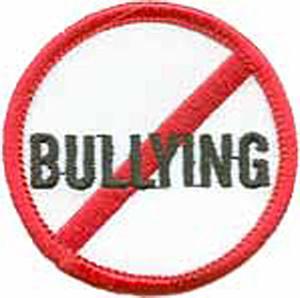
| We follow a ZERO TOLORANCE policy for bullying or unruly behavior. By any and all measure, Scouting is (and should be) considered a "safe zone" where boys can come and GROW in a positive and supportive environment.
Upon joining Scouts, boys are placed into a smaller unit called a Patrol - we currently have 2 patrols in our Troop. Per BSA guidelines, a patrol is "a group of boys (no more than 10) of similiar age, interests, and abilities."
BY DESIGN, your son will be among boys "like him" for most of his Scouting events. However, he will BENEFIT from the guidance and leadership examples of the older/larger boys who serve as Senior Leaders, Troop Guides, and skill instructors. Even in mixed-patrol competitions, we have only observed caring and supportive interactions... and we DO watch (just in case).
Scouting is a PRIVATE organization. Should any boy's behavior become intolorable, it is well within our right to "un-invite" him from being a Scout in this Troop.
| (Is there any hazing in Scouting?)Absolutely not. "Hazing" or similar types of practical jokes are simply not tolerated.
In Scouting, all are equal and treat each other with respect. In doing so, we learn to look past class, income, race, religion, nationality, and social status.
Despite the attacks from some of Scouting's detractors, there has never been a program so open and supportive of diversity as Scouting.
Considering this was taken into account in 1907, Lord Baden Powell was clearly a man ahead of his time.(Uniforms, What’s “official”?) 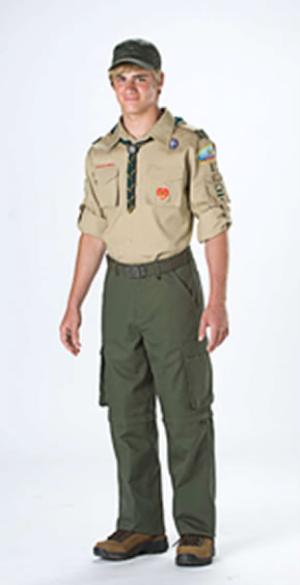
| Officially, the BSA has one uniform, and any historical version of it is acceptable (once official, always official). It is found in the front pages of every Scout Handbook. The official BSA uniform is comprised of: a troop neckerchief *
BSA tan shirt (with patches placed in the proper spots)
a Merit Badge Sash **
BSA olive pants
BSA web belt w/ buckle
BSA socks
This is the official uniform, but in many pieces of BSA literature it may be referred to as the Field uniform, or commonly, the "Class A" (a military term the BSA prefers NOT to use as the BSA does not wish to be perceived as a paramilitary organization). * Technically, hats and neckerchiefs (and how they are worn) are optional in the BSA Uniform Guide, but if the wearing of either is adopted by a troop, they are then considered official components of the uniform. The hat is the "baseball cap" variety imprinted with our troop number, and the neckerchief bearing our logo is to be worn UNDER the collar with the top button of the shirt unbuttoned. ** The Merit Badge Sash, worn over the right shoulder, is impractical for most Scouting-related activities. It is therefore only worn at ceremonial events or select meetings such as a Court of Honor. It is not always practical to wear the Field uniform shirt every minute a Scout is involved in a scouting-related activity. The BSA offers a variety of polo-type shirts and tee shirts imprinted with BSA logos, and many troops (ours included) often opt to have custom printed shirts made. It is customary practice that when a troop (as a whole) agrees on a standard shirt, they will opt to wear it instead of the BSA olive shirt, and in many items of BSA literature, this will be referred to as an Activity uniform, or sticking with military nomenclature, " Class B". Historically, the BSA offers major redesigns to the uniform about every 20 years. Three years ago, the BSA announced the "Centennial Uniform" with "switchback" pants and some color changes to troop number decals and shoulder loops. This is the 5th major redesign in the BSA's 100 year history.
| (What do I keep hearing about Scouting and Religion) 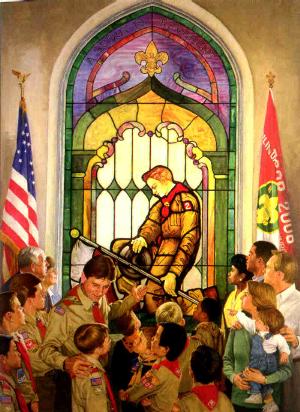
| Per the 12th point of the Scout Law, "a Scout is Reverent".
Scouting's founder, Lord Baden Powell, believed that it was crucial to the development of the "whole person" that we have a belief in, and love for, God and that we should live by and embody His laws and teachings.
Scouting does not promote any 1 denomination above another and works with organized religions to offer awards (officially known as the Religious Emblem Program) to any boys choosing to farther explore their religious faith, whatever that faith may be. Scouting proves it is SUPPORTIVE of diversity and religious differences.
As a Private organization, it is the right of the BSA to set a code or ethics and morals for its members to follow. Having a belief in God, is one of those criteria. Those professing NO belief in God may find they would be better served in a different youth program than the BSA.
As we believe that "being reverent" is such a critical part of the Scouting program, we openly pray during meals, at meetings, and during non-denominational "Scouts' Own" services which are held while we are away at camp. The troop maintains a youth member in the leadership position of Chaplain's Aid who will lead us in prayer and various services. | (Troop 792 – Fond du Lac, WI) 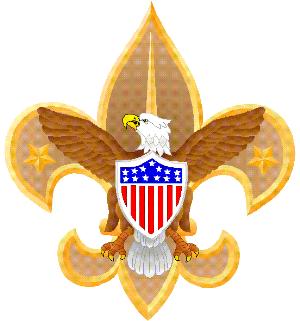
| We meet on Monday evenings from 6:30 til 8:00 PM at Church of Our Saviour located at 363 S Main St in Fond du Lac, WI 54937. Uniforms - Class B from May 15th till September 1st. Class A with neckerchief, at all other times. When we Travel to a Camp, we wear Class A (with neckerchief) both to and from the destination. We wear Class B while in Camp.
| (The difference between Rank & Merit Badges?)Rank is an interesting word choice, clearly derived from Scouting's origin as a program modeled after a military structure.
Those holding a "higher rank" do not order around those of "lower rank". In Scouting, the term "rank" is a PERSONAL measure of his progress along the "Trail to Eagle"... or more appropriately thought of as his "trail to manhood".
When a boy joins Scouting, his first POSITION is one of "Scout".
He then works on the first 3 RANKS; Tenderfoot, 2nd Class, and 1st Class. Within the requirements of these ranks, a Scout learns the safety aspects of Scouting; basic first aid, how to choose a safe camp spot, how to properly dress for an outing, how to find his way with map/compass, what to do if he gets lost, etc...
Now a demonstrated "safe" Scout... he is ready for his next period of personal development, which is leadership. In the pursuit of Star, Life, and Eagle, a youth is learning (and then mastering) the skills of leadership. By holding leadership positions within the troop, he learns to lead, instruct, and inspire others. He learns to "give back" to others, and also learns his emerging place in Society as a citizen.
There are 130+ various Merit Badges available (only 21 needed for Eagle). To ensure that the Scouts are getting a taste of the opportunities available, the higher badges of rank require a set number of merit badges be completed (including some designated as "Eagle required").
Merit Badges offer exposure to a diverse background of interests, adventures, and opportunities that Scouts may never experience IF NOT for the Scouting program (Aviation, Scuba, Reptile study, shooting sports, etc). It is not uncommon that exposure to a topic via the Merit Badge Program leads to life-long hobbies and career choices, as well as "needed skills" like Home Repair, Auto Mechanics, and Public Speaking.
There is no limit on the number of Merit Badges a youth may earn.(How do Scouts earn Merit Badges?)The day a boy signs his BSA application, he is eligible to start working on Merit Badges.
Completing a Merit Badge involves 4 people... The Scout, the Scoutmaster, the Merit Badge Councilor (MBC), and the troop's Advancement Chair.
The process:
1. Scout chooses a badge (or badges) that he'd like to work on (alone or with another Scout).
2 He informs the Scoutmaster of his intention to work on a badge, and is issued a "blue card" and given the contact information for a registered Merit Badge Councilor (MBC). A MBC can be ANY registered MBC in any Council. He is not obligated to work with councilors in his home unit or Council. CONTRARY TO URBAN MYTH, the Scoutmaster can NOT deny any Scout the opportunity to work on any badge, nor can he delay the badge being awarded once the MBC signs the "blue card" showing that it is complete. Judgment as to whether a Scout successfully completed the badge requirements rests solely with the MBC.
3. The Scout(s) contacts the MBC and make arrangements to meet as often as necessary to complete the badge requirements (following Youth Protection guidelines at all times). Upon the first meeting, the Scout presents the MBC with the blue card, which the councilor keeps so that he can update completion dates and keep track of the Scout's progress.
4. Upon completion, the MBC will sign all 3 segments of the blue card, and return it back to the Scout who in turn, presents it to the Scoutmaster for final signature indicating final recognition that all work is complete. Again, the Scoutmaster does NOT have the authority to deny, "retest", or delay the formal completion of any MB work.
5. The Scoutmaster will pass the signed segments along to the troop's Advancement Chairperson who will record the work on the Troop and Council levels, and ensure the Scout is presented with his badge on the next possible opportunity. *
* While NOT mandatory that a badge be presented right away, the BSA strongly encourages "instant recognition" for effort. The typical model is to present the badge by the next meeting, and present the "pocket card" during a formal presentation at the next Court of Honor.
6. The Scout will be given 1 segment of his blue card which he must keep so that it can be produced when applying for his Eagle Rank. The Troop should also retain a segment for their records as will the MBC for his records.
(What badges are “Eagle Required”?) 
| There are a total of 21 Merit Badges required for the rank of Eagle.
12 of these badges are Eagle Required "White Bands" (merit badges with white/silver border stitching around the edges).
The remaining 9 (or more if you choose) may be any badges from among the remaining 109 non-Eagle required "Green Band" merit badges (badges with green stitching around the border).
While there are 15 possible Eagle Merit Badges, there are some that are "optional". Refer to the picture to clearly understand which badges qualify for Eagle, and which ones do not. Earning more than one of the optional badges will nor afford you the choice to not earn other required badges, but "extra" Eagle badges can be counted towards the mandatory total of 21.
| (Can a boy be “demoted” or have badges taken away?)Once a RANK or a Merit Badge has been earned, it can never be taken away. In addition, once a Merit Badge Councilor signs a "blue card" stating that the badge requirement has been completed, no one has the authority to overturn the decision or refuse to award the badge to the Scout. (BSA policy)
Firemen' Chit and Toten' Chip are safety badges and it is at the discretion of the Troop Leadership to revoke a Scouts PRIVILEGES for fire-starting or knife/axe use. Should this ever happen, the corrective process is usually retaking the instructional course. Until that happens, a Scout is not permitted to carry/use a knife, nor may he start or tend a fire.(How many merit badges can I work on?)There is no limit to the number of merit badges a Scout can have "open" at one time. He may start working on Merit Badges the day he signs his registration form and has until his 18th birthday to complete the work.
Some units impose their own limits, but that is NOT BSA policy, and therefore, we do not endorse such restrictions.
That being said, the idea is to LEARN about a particular topic through the Merit Badge Program. A boy will be best-served if he strives to complete the work for a badge in a short enough time frame that ALL the information/lessons remain relevant. Again, this is at the Scout's discretion.(How fast can my son advance?)Advancment in Scouting is COMPLETELY under the control of the Scout himself.
As fast as he can learn the skills, he can get credit for them towards rank advancment.
TYPICALLY, it will take more than 1 year for him to make it from Scout, to Tenderfoot, to 2nd Class, and then to 1st Class. We do use a "1st Class in the 1st Year" agenda to keep newer boys focussed (and soften the "culture shock" from coming from a Cub Pack to a Troop). A Scout can work on the requirements for rank IN ANY ORDER, but his actual progression through the ranks must be sequencial.
Some of the rank requirements have SET TIMES that must be met before he can get credit for them and advance. These are clearly outlined in the back pages of his Scout Handbook.
A boy has until his 18th birthday to reach Eagle and/or be a Boy Scout, but the typical age of an Eagle in the BSA is a surprisingly young 14 years of age.
Reaching Eagle is NOT an easy task and requires an abundance of effort and self-motivation. Encouragement at home is CRUCIAL to a boy's success towards his Eagle Rank.
(What if my son is not advancing)We have to keep in mind that Scouting is a "character development program". One of the primary ways to create responsible young adults, is to give them "responsibility". One way to do that is to make advancement in Scouting the responsibility of each individual Scout.
Through his Patrol Leader, he should voice his desire for trip destinations, activities, and opportunities to complete the various rank requirements and attend trips that he finds exciting and thrilling.
He is responsible for informing the Scoutmaster (in advance) of his choice to begin working on a Merit Badge; the completion of which is up to HIM and his Merit Badge Councilor. Through INDEPENDENT work (with a friend or family member - to comply with Youth Protection) he will work with his MBC to complete Merit Badge requirements at his own pace.
At meetings and on camping trips, AMPLE opportunity is made to complete work and FREQUENT reminders are made to encourage boys to "step up" to make the most of their opportunities. Monthly camping trips ALWAYS geared towards a merit badge, though our weekly agenda rarely covers the entire badge requirements...and this is not by mistake. The "program" will offer OPPORTUNITIES for advancement, but we look to the Scout to "meet us half way" by stepping up to complete the rest of his requirements as a sign of his own initiative and work ethic.
Periodically, all boys will attend a Board of Review (BOR). Boys advancing to their next rank MUST attend the BOR as a requirement, but the Advancement Chair is also responsible for scheduling periodic BORs for boys who are NOT advancing to inquire as to the reason they are not progressing, or finding out what is "missing" in the Program.
AT ANY TIME, Scouts (with/without their parents) are free to inquire about advancement to the Scoutmaster or his Assistant Scoutmasters.
The SCOUT is ultimately responsible..... that's what makes the "Eagle" rank so significant and valuable. Attaining "Eagle" tells the world, that this is a young man who is responsible, motivated, and a leader.
(What is a Scoutmaster Conference?) 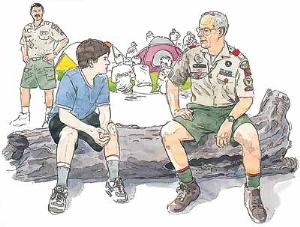
| After a Scout completes all the required tasks towards his next badge of rank, the next step is for the Scout to meet with the Scoutmaster for a "Scoutmaster's Conference".
The Scoutmaster's Conference SHOULD NEVER be a re-testing of any of his skills. Certifying his skills is the responsibility of the leader who "signed off" on his Handbook. Rather, the conference is a chance for the Scoutmaster to make sure all requirements are signed off, and then engage in a comfortable, yet detailed, discussion on how the Scout is feeling about the Program and how Scouting is fitting into his life as a whole. (This IS a character building program, if you didn't know.)
The Scoutmaster wants to hear from the Scout exactly what he likes, doesn't like, might want to do different, etc. He wants to know what his ambitions are in Scouting and "life". The ultimate goal is to make sure the Scouting experience is of real benefit to the Scout's development.
Once the Scoutmaster is convinced the Scout is ready to move forward towards the next rank, the Scoutmaster will direct the Scout to meet with members of the Committee, where a similar meeting will take place. This is known as a Board of Review. | (What is a Board of Review?)After a Scout complets his Scoutmaster Conference, he is to appear for a Board of Review. Amazingly, its functions just like a job or private high school interview (this is not by accident) where the Scout will basically be addressing 2 specific topics: - How is the Program (including adult leaders) running, and is there anything the Committee should/need to do to make the Program better?
- Why does the Scout feel as though he has earned his rank and is ready to move forward to the next rank?
There will be several questions put to the Scout by 3 to 5 Committee members comprising the Board, but ultimately, the 2 questions above are what is being addressed. For example, a Scout will not be asked to tie a square knot, but may be asked "which knot was the hardest, and how did you get yourself to finally learn it?" Like a job interview, the Scout MUST come properly dressed; wearing the full (clean and presentable) BSA Field Uniform. Per BSA policy a Scout should be in "as much of the uniform as possible" for a Board of Review. Since it "is possible" to be in full uniform, we prefer that Scouts be appropriately dressed as to help them realize that advancement is something "special". After meeting with the Scout, the Board will debate and if they are in unanimous agreement, will allow rank advancement to be recognized. A Court of Honor is a Boy Scouting awards ceremony, commonly held quarterly thoughout the year. At the Court of Honor, Scouts and their families gather for a formal recognition of advancement(s) and accomplishments that have been earned since the last Court of Honor. There are also periods for the Troop's Committee Chairperson to speak to the state of the Troop, or for some other event such as Scouting's annual Friends of Scouting campaign. By ceremoniously recognizing the value of advancement and hard work, we hope to strengthen a boy's motivation to continue being active within the Troop. The Court of Honor also gives parents/guardians valuable insight to accomplishments or Program happenings they may not see due to their lack of presence at the weekly meetings. As always, the goal is to ENCOURAGE, through positive reinforcement and praise. The ONLY age requirements established by the National Program are as follows: 10 years old to join (If completed 5th grade or earned AOL, otherwise must be 11) 12 years old by July 1st, to attend a National Jamboree contingent
13 years old to participate in COPE (14 preferred, 13 with Scoutmaster's recommendation)
13 years old to join a Venture Patrol 14 years old to join a Varsity Team 15 years old to join Sea Scouts or a Venture Crew 16 years old to become a Junior Assistant Scoutmaster 16 years old to be Youth Staff at a camp or Jamboree Day before 18th birthday - the last day you are a Boy Scout or Varsity Team member (includes Venture patrol). PRIOR to his birthday, all work (rank and badges) must be DONE. The Eagle Board of Review can occur after the 18th birthday, but work/project must be done PRIOR to the 18th birthday. Day before 21st birthday - the last day you are a Sea Scout or Venture Crew member
There are NO age requirements for ANY merit badges or youth leadership positions (other than JASM and Camp Staff) National publishes no "minimum age" for Eagle Scout Rank, but the earliest possible age a Scout could become eagle is 11 years and 5 months of age. (What is the minimum age to become an Eagle Scout?)The BSA does not list a minimum age before a Scout can earn his Eagle rank.
However, a boy must be at least 10 years old to join a Boy Scout troop, then there is a 30 day requirement in Tenderfoot requirement 10b, at least 4 months between First Class and Star, 6 months between Star and Life, and then 6 more months between Life and Eagle.
So the minimum possible age, while not listed as a "requirement", would be 11 years and 5 months.
The national average for those earning Eagle Scout is 15 years of age.
(What political party does the BSA endorse?)By National policy, the BSA is APOLITICAL. We have no affiliation with any one political party, nor are Scouts (in uniform) permitted to act in ANY WAY that would be interpreted as giving support to any 1 political party or political issue.
Uniformed Boy Scouts may serve as the Color Guard at political events, but must exit the stage before any political speeches or grand-standing take place.
By Constitutional Charter, the President of the United States is the Honorary President of the BSA.(We’re looking at troops. What should we look for?) 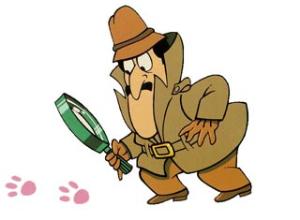
| WHAT should you look for when you visit a troop? WHAT are some signs of a "good" unit? Keep these questions in mind... - How is the attendance? (low enrollment and/or attendance may indicate a troubled program.)
- Were the boys AND leaders in the proper uniform? (RUN from any troop that allows the "bluejean brigade", where they are only in uniform from the waist up. If they don't promote the basic uniform, rest assured that other things are missing too.)
- Are boys advancing at an individualized rate? Is there a mix of ranks among the Scouts, even in the same patrols? (Right answer is "yes")
- How many eagles did they have last year? (Beware of "Eagle Farms".) On average, only 2 per 100 boys in Scouting make it to Eagle. Rates higher than average demand scrutiny as they may be too lax about advancement requirements, or may indicate an "adult prepared" agenda. "Eagle" is earned by the boys making the effort to achieve on their own initiatives, not by being "spoon fed" an agenda of merit badge coursework over a pre-defined schedule.)
- Were you welcomed? Did they make you feel genuinely welcomed and wanted?
- Who is teaching? Boys or adults? (With the exception of "advanced" skill instruction, boys should be running the meeting, not adults.)
- Are they having FUN? Do boys look interested, or bored?
- Are there boys of various ages? (Big gaps in enrollment may indicate periods of a problem program or "issues" with the adult leadership.)
- How long has the Scoutmaster been the Scoutmaster? (A "new guy" may be lacking experience, and "old timers" generally lack "updated program" changes.)
- Is there room for you as a leader or on the Troop Committee? If you're told, "we're all full", that is NOT a good sign!
- Are the boys well behaved? Do they respond to the "Scout Sign" or was someone screaming "SIGNS UP!!!"? Any screaming is a warning sign.
- Ask what trips they've had, and what they have planned. Do they do the same thing every year, or are they always trying something new and exciting?
- Watch your son! Did he blend in? Did the boys make efforts to include him?
- Watch for different "stages" of the Troop meeting. There should be distinct periods of Skill Instruction, Patrol time, Inter-patrol Activity, and some formal opening and closing ceremonies.
- Finally, what are the facilities like? Is there adequate meeting space.. storage space...space to "do things"? (OK, we are a little biased since we have our own gun ranges, fish pond, archery range, stream, field, etc....)
| (What is the ONE bit of advice for a Scout?) 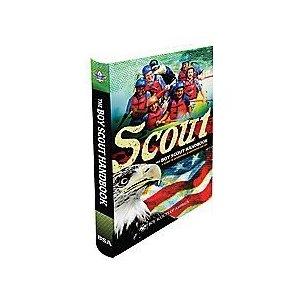
| READ THE BOOK !
The Boy Scout Handbook does an EXCELLENT job explaining the BSA Program.
It also provides valuable skill instruction and has the potential to IGNITE dreams of adventure, exploration, and fun for boys of all backgrounds and abilities.... all of which are POSSIBLE in this troop!
"I'm bored" are the 2 words NO Scout has a right to say, as we are determined to help bring all their ideas into reality.
Spend time with your son each night (especially if he is new to Scouting). Read the book with him. Quiz him on a skill, or "challenge" him to a knot tying contest. Ask him how he sees himself living up to the Scout Law.
Don't let Scouting be "1 hour a week" each Monday night, but a regular and routine part of every day.
| (What is a “Scout Account”?) 
| Along with managing the general fund needed to maintain the program (awards, equipment, camp ground fees, etc) the Troop Treasurer also manages a virtual "account" for each Scout. This account can be used for ANY Scouting-related expense, from dues, summer camp fees, to equipment for a merit badge class (such as a fishing rod for Fishing MB).
HOW IS IT FUNDED?
When fund raising events are approved by the Committee, the purpose of fund raising will be stated (fund the Troop fund, fund an event, fund the boys accounts, or a combination thereof). In MOST events, some portion of fund raising will be designated for those who participate in fund raising effort. The idea is that the more a boy works, the more he reaps the reward for his labor. In doing so, he contributes to the overall good of the troop and pushes fund raising events to their maximum effectiveness. It is a win/win scenario.
HOW DO SCOUTS ACCESS THE FUNDS?
The funds are paid out as a REIMBURSEMENT for a Scouting-related expense. Scouts are to inform the leader what they bought and how it related to Scouting, then present the sales receipt. By the following meeting, reinbursement in the form of check will be presented to the Scout. Scouts should clarify in advance, any expense that would seem "questionable".
What happens to the funds if a Scout transfers to another unit or quits Scouting?
By Committee decision, a boy who remains in Scouting, but decides to transfer to another unit, deserves the benefit of his labor. Upon confirmation of transfer paperwork, we'll distribute the balance in his Scout account to him.
Those who quit scouting forfeit the contents of their Scout Account and the funds will be rolled into the general Troop Fund. (see Note below to understand why we do not "refund" account balances)
NOTE- Per BSA Guidelines, all money and equipment held by a Scouting Unit is the lawful property of the Charter Organization (not the Troop or its members). Money does not "belong" to any 1 Scout, but rather exists to enrich his Scouting experience. A boy who opts out of the Scouting Program, is no longer privy to money DESIGNATED specifically for Scouting purposes. He can not claim "reimbursement" for it was never lawfully "his". | (Do all boys carry knives?) 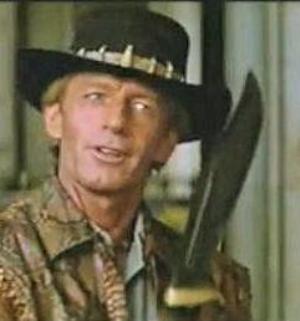
| A knife of some type (typically folding pocket knife) is an integral part of the Scouting Program. A knife serves many purposes from eating utensil to wilderness survival gear, and most boys do carry a knife when they go on a camping trip.
HOWEVER, all Scouts must pass instructional safety training to understand the STRICT provisions for using a knife safely, and at appropriate times, before he is allowed to possess or use a knife. The training covers the use of saws, hand axe, long axe, log splitters, as well as pocket knives.
This training is known as the Totin' Chip and has a corresponding award of the same name. The award may be the pocket card (size of a business card) or if sold in the Council's Scout Store, a Toten Chip patch. The patch is "official" in the BAC/Dulaney district. The card is now considered a part of the official uniform. A scout is expected to have his "Toten Chip" with him if he is carrying his knife.
If a Scout falls short in his responsibility of safe knife handling, he may lose his Toten Chip privileges and it is up to the Scoutmaster's discretion as to how the privilege can be re-earned. In Troop 792, it is typical that a Scout who loses the privilege must repeat training, AND then TEACH the Toten Chip session to another scout. | (What kind of knives can Scouts carry?) 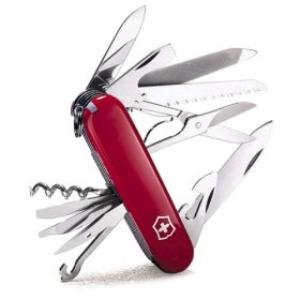
| Contrary to urban myth, the only regulation on this (other than earning the Totin' Chip award) is the restriction that may exist at part of State/Local law. National BSA DOES allow Councils and Districts to set their own rules, so long as the rules result in a SAFER result.
As of today, neither the Longs Peak Council or the Indian Peaks District impose their own limitations on knives beyond what already exists as Colorado law.
While the BSA strongly encourages folding (preferably locking) pocket knives, those that are categorized as "fixed-blade" or "sheath" knives are allowed. In fact, the Guide to Safe Scouting specifically lists "fillet" knives as a prime example of a sheath knife that is appropriate for Scouting purposes (Fishing MB requirements). Fixed blade/sheath knives are big, bulky, heavy, and generally far more "knife" than a Scout needs.
Some BSA camps impose their own limitations, which visiting Scouts are obligated to respect, regardless of Troop or BSA/BAC policy.
Troop 792 respectfully asks that adults encourage their sons to carry the appropriate knives (small, folding pocket knife), as these are more than adequate for 99% of all scouting activities. In fact, "cheaper is better" because they may scar their blades by using flints to start fires, or may easily lose their knives in the course of daily activities.
| (Do you sleep in tents, cabins, open sky?) 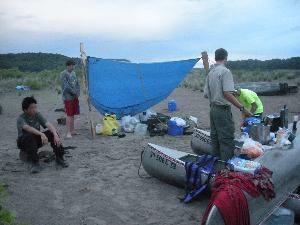
| In the months of January, February,and March we have traditionally done "cabin camping". However, when Patrol Leaders' Council decides to tent camp in winter months, we respect that decision.
When in cabins, scouts sleep in bunk beds and there is typically a wood burning stove(s) for heat. Most of cabins tend to have some type of kitchen facility, though the size and quality vary widely.
The remainder of the year is typically "tent camping". The troop maintains an adequate supply of 4-man, "A-frame" tents.
If boys so choose (hopefully as a patrol), they can sleep under the open sky (no tent) or for those feeling even more adventurous, such as those working on their Wilderness Survival merit badge, they may choose to build their own structure and sleep in it overnight.
| (What gear is required for camping?)The Troop Committee is charged with ensuring that enough equipment is procured to support camping trips. Each patrol will have provided for them:
- tents
- cooking utensils
- cook stove w/ propane tank
- wash bins (for washing dishes)
- water jugs
- propane lanterns
Scouts will need to have the following personal gear, and may be prevented from attending a trip if they do not have:
- sleeping bag (weather/temperature appropriate)
- eating utensils (fork, knife, spoon, bowl, cup, AND water bottle) *
- proper clothing (including hat & weather footwear)
- rain poncho & rescue whistle
- personal first aid kit (described in detail in the Handbook)
- flashlight (and extra batteries)
- personal hygiene items (Toilet Paper, tooth brush, deodorant, etc)
- Backpack (preferred) or duffel bag
* Please do not buy the "Personal Mess Kits" at camping stores that include individually sized pots/pans. These kits include MANY parts that are unnecessary for consuming standard camp meals and become clutter/mess at camp.
In addition to the required items above, the following items are very helpful:
- folding camp chair (to sit around campfire or camp)
- "travel-size" games or playing cards (non-electronic)
- pocket knife (if he has earned Toten' Chip)
- compass WITH a BASE PLATE
- hiking stick or stave
- sunscreen & insect repellent
- matches or matchless fire starter
(How big is the Troop?)As of December 1, 2014 BSA Troop 792 has grown to 14 Scouts ranging in age from 11 to 17. There are 17 uniformed leaders (3 of which are Eagle Scouts) most of who are regular attendees at the weekly troop meetings, and numerous other adults registered as committee members and/or merit badge councilors, each committed to the well-being and growth of the Scouts, and the spirit of the Scouting Program as designed by the National Council. (Can I attend with my son?)Other than high-adventure bases like Philmont or Sea Base where adults are required to be BSA Registered Leaders, there is nothing in the BSA Program that prevents parents or legal guardians from attending camping trips with their sons. The Guide to Safe Scouting says, "There are NO 'secret societies' in Scouting. An adult may attend any scout function with their son". THAT BEING SAID... there are some guidelines visiting parents are expected to follow. 1. The "BSA Youth Protection" guidelines MUST be followed at all times. Registered leaders can explain these to you if you are not already familiar with them. 2. Part of you son's camp experience is to become a functioning member of his patrol, and this includes some trial & error experiences. Therefore, he WILL sleep with his patrol, eat with his patrol, do KP (Kitchen Patrol) duties with his patrol, and perform campfire skits with his patrol. You may watch and advise if needed... but you're expected to LET HIM "do". If you find yourself holding a spatula, pot/pan, or matches in your hands... you're doing too much!!! 3. Attending parents will eat, tent, and in all other ways, "function" among the attending adults. Expect to be "put to work" over the weekend as an "adult leader", which means working with all troop members, not just your son. 4. Smoking, chewing tobacco, alcohol, profanity and the like are NOT welcome in Scouting. We expect (and at BSA camp grounds it is required) that you do not smoke at Scouting events. If you feel that you "must" smoke, you are expected to not be in view of any Scouts (our troop or other). 5. Do not expect your son to sleep in your tent. While it is "technically" allowed under BSA Youth Protection, it impedes his development as a self-reliant Scout and slows his cohesion with the rest of his Patrol. We STRONGLY discourage any excuses to bunk with your son. 6. Siblings are not welcome to remain at over night excursions, the only exception being 2nd Year WEBELOS scouts. Although WEBELOS scouts are actually encouraged to begin interacting with a Boy Scout troops, please check in advance with the Scoutmaster to ensure that our camping agenda is appropriate for WEBELOS-aged boys. If they are not, we must request that they not attend. 7. Non-legal guardians (boy/girl friends of single parents) are not to remain over-night at camping excursions. 8. Adults who plan to attend camp MUST inform the Scout Master 1 week ahead of time (indicate attendance on the Permission Slip) and contribute to the funding of meals and camp/cabin fees. Please keep in mind that Boy Scouting is a pathway from "boyhood" to "manhood". It is BY DESIGN that your son start working WITHOUT your assistance and involvement. We all want to see our sons be the perfect fire-starter, perfect cook, etc... but making mistakes and "finding his own way" is part of what happens here. You'll be surprised what he's capable of doing on his own. :-)(What is Venturing?) 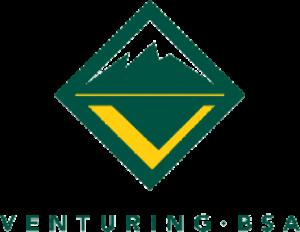
| Despite its 100 year old heritage, Scouting is a "constantly evolving" program. One of the things National BSA realized over the last few years is the need to offer "High Adventure" activities to retain older boys who find high school, jobs, girls, sports, etc. competing for their time. "High Adventure" units are SPECIFICALLY DESIGNED to cater to older boys who are grouped together in their own patrol, so they can take on the "high adventure" activities while maintaining the patrol unity. [again, supporting why Patrols should not have mixed-ages of boys] High Adventure groups can be "Venturing Patrols" (a patrol within a troop), or a separately chartered unit known as a "Venturing Crew". Venture Crews (age 14 to 20) can be co-ed, providing both male and female leaders are registered and present. They are COMPLETELY member-led and have minimal adult involvement. | (Can I “sign off” on my son’s requirements?)This is one of our most common questions, and the answer is "no" (and should have been "no" when he was a WEBELOS Scout as well.)
In Boy Scouts, it's not enough that a Scout "did it once before" or was "there the night we talked about bla bla bla.." A Scout must show proficiency and understanding of the rank requirements in the presence of a registered adult leader. Only then can he get "signed off" on the requirements in the back of his Handbook. This can be done by a uniformed adult, or a Scout who has been entrusted with the job of skill instruction.
(What if our Cub Pack has a brother Troop?)Do you need to bridge into the Troop where you are currently a Cub Scout? Absolutely not!
Just because a charter organization has both a Cub Scout pack and a Boy Scout troop, a boy bridging into Boy Scouts is NOT obligated to bridge into that particular Troop. If you are given pressure to do so.... that's probably a sign for you to look around! A unit with a good Program doesn't need to "recruit" or pressure boys to join.
While all Troops (should) follow the same BSA Program designed by the National Council of the BSA, you will find every troop has a program that has a LOT of differences from other units. Some predominantly like to HIKE, others BIKE, some CAMP while others CANOE. Some are "year round" (we are), and others take a summer break. Some mix boys of various ages in patrols, others don't.
It's in your son's best interests to shop around and make sure the place he is likely to spend the next 7 years of his Scouting career is going to be the best fit for him.
Troop 792 does have a "feeder" Cub Pack... and YES, we encourage them to shop around as well. A boy should have NO pressure placed on him as to which troop to join.
We draw boys from packs and troops all over the area. Our Program is strong, our facilities are BETTER than most scout camps, and (sadly) you will find our dedication to doing things "by the book" is more rare than it should be.
Please shop around. If you'd give us the honor of your consideration, we'd love for you to be our guests one night(Wouldn’t it “run smoother” with adults in charge?)Yup... it probably would. But why would we want that?
This is BOY SCOUTS... not "fathers getting away for the weekend" Scouts... nor is it "WEBELOS 3" where adults are in the leadership role as in the Cub Scout program.
This is where boys LEARN and DEVELOP their leadership skills so they can become capable young men. We DON'T EXPECT them to be the most efficient and organized leaders (and neither should you).
This is their learning ground. Here is where we want the "mistakes" to happen, so they can learn from them. This is how we TEACH leadership skills instead of getting adults to "step in" because we could be "more efficient".
Remember... the program is NOT DESIGNED to run perfectly.
They may elect their "best friend" instead of the "most qualified"... and they will experience the consequences of casting a "careless vote". They may elect the Class Clown instead of the Class President... and NEED to "suffer" through a few months of a weaker or chaotic Program.
Remember, nothing happens here by accident. Trust us. Trust the 103 year old program. Have faith. Keep your boy coming especially if he comes home with a few "complaints" on how things are being done. Ask him what he would do differently or what he did to try to correct what appears to be a "screwed up" situtation. HERE is where the program really shows its value.
|
|
 |
 |
|
 |
 |
 |
 |
|
|
|
|
|
|
|
|
|